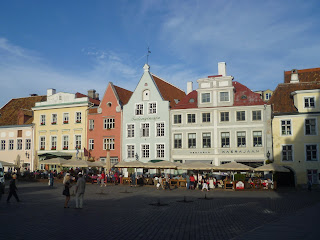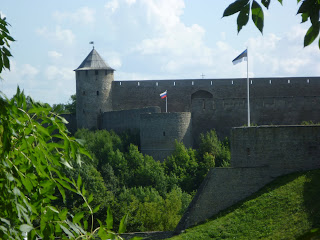Tallinn, the capital of Estonia, is one of the European Union’s success stories. Popular with tourists for the charming, colourful architecture and cobbled streets of its old town, it is also something of a booming financial centre; earlier this year Estonia became the first former eastern bloc state to adopt the single European currency.
Tallinn’s medieval centre (left) is surrounded by a modern business district, with no shortage of shiny new shopping centres, office blocks and plush hotels. Undeniably, there are nods to Soviet architecture, as wide boulevards adorned with images of the worker run alongside more recent developments.
But for a flavour of communist Estonia, visitors should take the three-hour bus trip across the width of the nation to the city of Narva, perched right on the Russian border.
Arrival, on the city’s southern side, hardly gives a flattering first impression of this EU outpost. The symmetrical pattern of the housing blocks that surround the bus terminal (such as it is) are shabby-looking, peeling structures that could be taken straight from a communist builder’s instruction manual.
Even the (slightly) more luxurious houses, as opposed to blocks of flats, are ringed by crumbling pavements and bright, sagging and overgrown weeds.
Walking towards the city centre offers a few more signs of prosperity, but even the grandest hotel is reminiscent of properties in a failed seaside resort. Shops, while undoubtedly well-stocked and so accompanied by the air of prosperity that that brings, are grey and hardly enticing from the exterior.
Staring forlornly at the Russian Federation from the other side of its eponymous river, Narva, particularly when compared to its capital, gives the impression that it would rather it was governed by Moscow.
Closer, both in outlook as well distance, to St Petersburg, than to Tallinn, this impression is confirmed by the nature of its inhabitants, who number around 70,000 – a figure that has been declining since the collapse of the Soviet Union thanks to poor job prospects and the promise of greater prosperity elsewhere.
95 per cent of Narva’s populace speak Russian as their first language; four in five are ethnically Russian, and fewer than half are even Estonian citizens. The city’s Orthodox Cathedral is a relatively busy hub of activity, a stark contrast to the somewhat-forgotten, if newly renovated Lutheran version, the strand of Christianity adhered to by most in the Baltic States. Signs in shop windows, bus timetables and advertisements are in Russian as well as Estonian.
As such, both the physical make-up as well as the attitude of Narva indicate its apparent desire to face east. Adjacent to one of the main junctions in the centre of town – again, a communist-esque roundabout that lies among sweeping, arrow-straight streets, is the residential block (left) that typifies, almost stereotypically, the bland and depressingly mundane Stalinist architecture.
It really does seem like you are taking a step back in time when you walk through this paradise for adherents of concrete. The one significant tourist attraction, unsurprisingly the sole remnant of bustling medieval Narva, is its castle, which engages in a permanent face-off with an equivalent fortress on the Russian side of the river in Ivangorod (above).
This castle, though, is hardly enough to tempt the majority of tourists. Unless you are travelling to or from Russia, Narva might barely be seem worthy of a stopover. Even so, it is a fascinating example of the old Eastern Europe; accessible yet authentic.





No comments:
Post a Comment